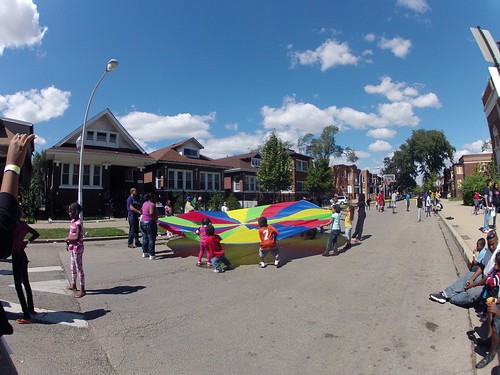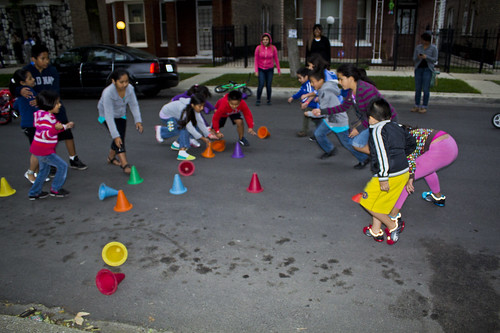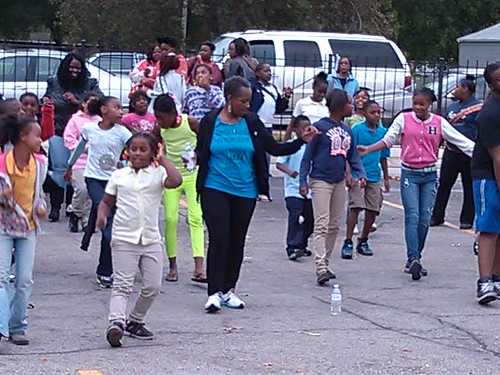Two of the biggest problems facing local youth, and Chicagoans in general, are street crime and the obesity epidemic, partly due to a lack of safe outdoor spaces for physical activity. PlayStreets, an initiative launched last year by the Chicago Department of Public Health, addresses both of those initiative by closing off city streets to traffic in low-income communities of color for three-hour intervals to create safe places to play.
Although most of the sessions, which included activities ranging from Zumba to basketball to chess with giant pieces, took place in the late fall, nearly 4,000 people, most of them young people, participated. This year, with the events taking place in warmer weather, there should be even better participation. The program resumes with Spring-PlayStreets during the Chicago Public Schools spring break from March 25-29. I recently spoke with Andres Alvear, director of education and outreach for the Active Transportation Alliance, which helped facilitate the program, for his take on how things went last year.
John Greenfield: What is PlayStreets?
Andres Alvear: PlayStreets is an initiative funded by the local Blue Cross Blue Shield of Illinois with support from the Chicago Department of Public Health. The community partners include Beyond the Ball in Little Village; Southwest Organizing Project in Chicago Lawn; the Network of Public Safety Alliance in Woodlawn; and Claretian Associates in South Chicago.
It’s a community-driven approach to get people more physically active, and also a way to promote public safety in neighborhoods across the city. We do this by closing the public right-of-way, similar to a block party, to provide residents an opportunity to do physical activity but also to interact with their neighbors. It’s Play activities, family games, sports, all of the above.
So the city piloted this project last year. Active Trans, World Sport Chicago and LISC [Local Initiatives Support Corporation] Chicago were the grantees and we piloted this in the four communities on the South Side. We did 50 PlayStreets events. All of them were recurring events so there was a street that was closed [for three hours at a time] for a number of weeks and so it promoted a recurring sense of streets being closed for public use.
We had kids and their family members come out. We programmed the events so there were some activities that families could sort of self-select, like hula-hoops and jump ropes. And then we had some activities that were semi-organized like basketball, softball and soccer games.
JG: What were the most successful aspects of PlayStreets last year?
AA: I think what we learned is that this is a very practical way to get community members to interact with one another. Not only to interact in physically active ways and using the public right-of-way, but it’s also a very practical way for communities to think about public space and safety in a different way. So you have residents being able to go outside every afternoon in Little Village and not thinking about, necessarily, is it going to be safe or not. That was something that we learned from the initiative. We really thought about it as an obesity preventive initiative. We didn’t really think it would be a public safety initiative.
JG: Are you talking about a safety in numbers thing where people were less worried about crime because all the neighbors are out?
AA: That’s right. What we heard is that the more neighbors get a chance to interact with one another outside in their neighborhood, the more likely there will be a sense in the community that there are certain things that are just not allowed, like standing around and gang activity. We worked with a number of community-based organizations to make this happen, we didn’t do it alone, and that’s what we heard back from them, the impact that they were seeing in the communities.
JG: Are you going to do anything differently this year?
AA: Last year we were limited by the way our funding was given, that we could only serve South Side communities. So this year we’re looking to do more PlayStreets on the West Side and North Side of the city, prioritizing underserved communities and communities of color. So that’s one way in which we hope to improve the work.
We’re also looking at ways that we can include programming that’s more inclusive of parents. We’ve had a lot more kids than we’ve had adults, and adults tended to think of PlayStreets as something that was more for kids and not for families. So we want to do more activities that encourage parents to participate and be more involved.
JG: What kind of activities would you do that might get parents involved?
AA: One activity that we did on the South Side that was really successful was line dancing. When we did line dancing we found that a lot of the adults and parents wanted to participate, they wanted to dance. So looking to do more activities like that. It was a lot of fun and the community-based organization that we worked with kept telling us that this would be the way to go. We were somewhat skeptical, but when we tried it, it turned out hundreds of people. They were dancing on the street. It was quite great.
JG: So it might sort of evolve into being sort of like a miniature Open Streets [Chicago’s “ciclovia” car-free event]?
AA: Yeah, you could say that PlayStreets is potentially a micro version of Open Streets. It’s not as programmed but it’s a neighborhood-level street closure on a recurring basis.
JG: What do think PlayStreets says about the way we use our streets? What happens when you take a street and you stop using it for moving cars and turn it over to a different use?
AA: Well, the reason that Active Trans is involved is we’re hoping that people think about the right-of-way in a different way, and also that they’re more aware of the way that they get around and think about the streets as being for people instead of just cars. We want them to know that they can also get around by bike or walking. So that’s our hope.






